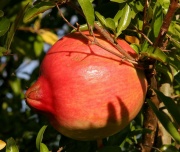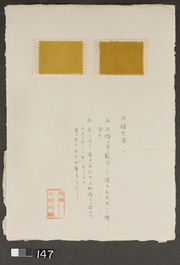Difference between revisions of "Pomegranate"
Jump to navigation
Jump to search
(username removed) |
|||
| (5 intermediate revisions by 2 users not shown) | |||
| Line 3: | Line 3: | ||
A fruit and shrub (''Punica granatum)'' native to southwestern Asia but now cultivated worldwide. Pomegranate rind, a natural yellow dye, is extracted from the skin of the unripe fruits. It has been used as a tannin and colorant for leather. Wool dyed with pomegranate extract is usually brown or black. | A fruit and shrub (''Punica granatum)'' native to southwestern Asia but now cultivated worldwide. Pomegranate rind, a natural yellow dye, is extracted from the skin of the unripe fruits. It has been used as a tannin and colorant for leather. Wool dyed with pomegranate extract is usually brown or black. | ||
| − | + | * See also [[https://cameo.mfa.org/wiki/Category:Uemura_dye_archive '''Uemera Dye Archive''' (Zakuro)]] | |
== Synonyms and Related Terms == | == Synonyms and Related Terms == | ||
| − | Punica granatum; pomegranate rind; pomegranate peel; dalim; Natural Yellow 7; Granatapfel (Deut.); Grenadine (Deut.); granada (Esp.); grenade (Fr.); granaatappel (Ned.); granatowiec właściwy (Pol.); romã (Port.); granatäpple (Sven.) | + | Punica granatum; pomegranate rind; pomegranate peel; dalim; Natural Yellow 7; Granatapfel (Deut.); Grenadine (Deut.); granada (Esp.); grenade (Fr.); granaatappel (Ned.); granatowiec właściwy (Pol.); romã (Port.); granatäpple (Sven.); zakuro (Jap.) |
| − | |||
| − | |||
| − | |||
| − | |||
| − | |||
| − | == | + | [[File:Uemura 06-04-2009 147.jpg|thumb|Silk dyed with pomegranate husk; Uemera Dye Archive]] |
| + | == Physical and Chemical Properties == | ||
| − | + | * Rounded shrub growing to 6 m. | |
| + | * Bark=smooth aging to irregular ridges and furrows. | ||
| + | * Leaves, often evergreen, simple, leathery, ovate (1-3 inches long) | ||
| + | * Fruit=Round (to 4 inches), leathery red rind containing sacks of sweet red pulp surrounding seeds. | ||
== Additional Images == | == Additional Images == | ||
<gallery> | <gallery> | ||
| − | File:04 pomegranite.husk.int.det.jpg|''Zakuro'' | + | File:04 pomegranite.husk.ext.grp.jpg|''Zakuro'' husk |
| − | File:04 pomegranite.husk.int.grp.jpg|''Zakuro'' | + | File:04 pomegranite.husk.int.det.jpg|''Zakuro'' husk |
| + | File:04 pomegranite.husk.int.grp.jpg|''Zakuro'' husk | ||
</gallery> | </gallery> | ||
| − | + | ==Resources and Citations== | |
| − | == | + | * C.Ben Nasr, M.Metche, "A Study of the Association of the Tannins in Pomegranate Peel with Wool Proteins: Effect on Colour" ''Dyes in History and Archaeology'', No.15, Paper presented in Manchester England, Nov. 1996. |
* Colour Index International online at www.colour-index.org | * Colour Index International online at www.colour-index.org | ||
| Line 33: | Line 33: | ||
* A.Lucas, J.R.Harris, ''Ancient Egyptian Materials and Industries'', Edward Arnold Publishers Ltd., London, 4th edition, 1962 | * A.Lucas, J.R.Harris, ''Ancient Egyptian Materials and Industries'', Edward Arnold Publishers Ltd., London, 4th edition, 1962 | ||
| − | * Wikipedia | + | * Wikipedia: http://en.wikipedia.org/wiki/Pomegranate (Accessed Dec. 9, 2005) |
| − | * | + | * Virginia Tech Dendrology website at www.fw.vt.edu/dendro/dendrology/main.htm (Accessed Dec. 9, 2005) |
[[Category:Materials database]] | [[Category:Materials database]] | ||
Latest revision as of 12:06, 22 June 2022
Description
A fruit and shrub (Punica granatum) native to southwestern Asia but now cultivated worldwide. Pomegranate rind, a natural yellow dye, is extracted from the skin of the unripe fruits. It has been used as a tannin and colorant for leather. Wool dyed with pomegranate extract is usually brown or black.
- See also [Uemera Dye Archive (Zakuro)]
Synonyms and Related Terms
Punica granatum; pomegranate rind; pomegranate peel; dalim; Natural Yellow 7; Granatapfel (Deut.); Grenadine (Deut.); granada (Esp.); grenade (Fr.); granaatappel (Ned.); granatowiec właściwy (Pol.); romã (Port.); granatäpple (Sven.); zakuro (Jap.)
Physical and Chemical Properties
- Rounded shrub growing to 6 m.
- Bark=smooth aging to irregular ridges and furrows.
- Leaves, often evergreen, simple, leathery, ovate (1-3 inches long)
- Fruit=Round (to 4 inches), leathery red rind containing sacks of sweet red pulp surrounding seeds.
Additional Images
Resources and Citations
- C.Ben Nasr, M.Metche, "A Study of the Association of the Tannins in Pomegranate Peel with Wool Proteins: Effect on Colour" Dyes in History and Archaeology, No.15, Paper presented in Manchester England, Nov. 1996.
- Colour Index International online at www.colour-index.org
- Helmut Schweppe, Schweppe color collection index and information book
- A.Lucas, J.R.Harris, Ancient Egyptian Materials and Industries, Edward Arnold Publishers Ltd., London, 4th edition, 1962
- Wikipedia: http://en.wikipedia.org/wiki/Pomegranate (Accessed Dec. 9, 2005)
- Virginia Tech Dendrology website at www.fw.vt.edu/dendro/dendrology/main.htm (Accessed Dec. 9, 2005)




